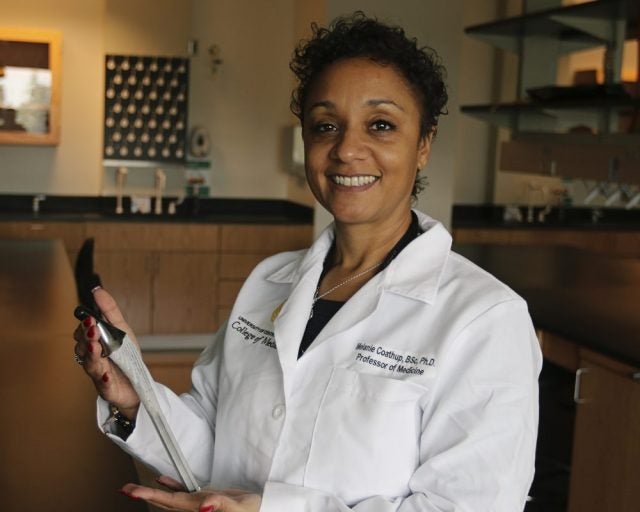UCF research may lead towards an exciting future where the blind see again, neurostimulator implants help relieve chronic pain and war veterans feel the sensation of touch in their prosthetic limb.
Dr. Melanie Coathup, an internationally recognized specialist in bone regeneration and implant design, has been hired to lead the university’s new Prosthetic Interfaces faculty research cluster, which will work on big problems like these.
The clusters benefit from the strengths of interdisciplinary expertise to tackle large problems, like cybersecurity and renewable energy systems, from multiple perspectives. There are ten core faculty members in the Prosthetic Interfaces cluster – six from the College of Medicine and four from the College of Engineering & Computer Science.
Previously, Coathup was a professor and researcher at University College London’s Institute of Orthopaedics and Musculoskeletal Science, serving as head of the Centre for Cell and Tissue Research. She had spent the past 23 years at UCL, where she was instrumental in establishing their interdisciplinary Medical Sciences & Engineering program. During her career, her research has led to new implant designs for bone cancer patients and the development of a new kind of synthetic bone material to help patients with skeletal injuries regenerate their tissue for a speedier recovery.
“It’s important to expose yourself to new people, new ways of solving things, new equipment and new ideas,” she said. “There’s a chance to build something from scratch – to create something, and be involved in this huge growth that’s happening here.”
The researchers will focus on interfaces for implantable devices, which include artificial hip and knee replacements, as well as pacemakers, neurostimulation devices and cochlear implants. An estimated 25 million Americans are dependent on implantable devices for sustaining them.
“Our use of materials in the body is increasing,” Coathup said. “Decades ago, you were just trying to replace a part. But now, you’re trying to make them smart. You’re trying to make them dynamically interact with the body. You maybe want to have them deliver drugs, or monitor fluids.”
Current prosthetic devices can be prone to degeneration over time, as well as infection. That’s why the materials they’re made from – and the substances they’re coated with – are vital. Vital, too, are the development of smart sensors, which could provide early warning systems for prosthetic device failure.
“I think that a good part of the future of improving patient care is improving the biomaterials that we use, and improving the body’s integration with them,” she said.
Each faculty member of the cluster will contribute their expertise towards the goal of developing intelligent prosthetics. Some, like Kiminobu Sugaya, professor of medicine and head of the College of Medicine’s Neuroscience Division, will focus on improving the brain-machine interface, which would allow for enhanced neuromuscular control and sensory feedback.
Others, like Sudipta Seal, Pegasus Professor and chair of the Department of Materials Science and Engineering, have expertise in nanostructures and biomaterials to build and coat prosthetic devices with.
Elisabeth Brisbois, assistant professor of materials science and engineering and part of the cluster, has researched nitric oxide-releasing polymers that could fight off infection. Working with a multidisciplinary unit will allow researchers to cross-pollinate ideas, she said.
“The collaborative nature of this cluster will have significant impact on research, as it gives us the opportunity to work at the interface of engineering and medicine, fostering advances in both fields.”
The community is already sitting up and taking notice. Albert Manero, president of Limbitless Solutions and a UCF alumnus, is thrilled about his alma mater prioritizing this area of research. At Limbitless, a direct support organization of UCF, he and his team create custom bionic limbs.
“The progress the university has made in developing out this type of research is going to go so far in really having a tangible impact on our community,” he said. “We’re really excited to see the partnerships that are going to develop.”
Coathup anticipates interest in their research from hospital systems, government entities like the U.S. Army, Department of Defense and DARPA, and private entities, with the potential for commercialization of any technology developed.
She’s excited to collaborate with BRIDG, the advanced smart sensor manufacturing center in Kissimmee, as well as the physicians at the VA Medical Center and Nemours, all of which are near her lab in Medical City.
Her focus now is on bringing on new forward-thinking faculty in areas like biomechatronics and neural engineering with the intent of developing undergraduate and graduate curricula later down the road.
She’s also fostering local, national and international relationships with other physicians, engineers and scientists to take the cluster’s research from bench to bedside.
“We need to have clinicians on board,” Coathup said. “We need to know what the clinical challenges are. And then we can develop solutions, eventually leading towards clinical studies, clinical trials, as well as new products that can go into the hospital arena.”
